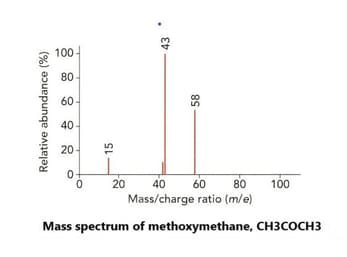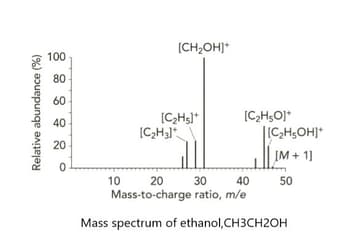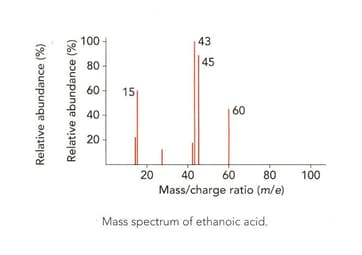Lawrie Ryan and Roger Norris Solutions for Chapter: Atoms, Molecules and Stoichiometry, Exercise 5: Question
Lawrie Ryan Chemistry Solutions for Exercise - Lawrie Ryan and Roger Norris Solutions for Chapter: Atoms, Molecules and Stoichiometry, Exercise 5: Question
Attempt the free practice questions on Chapter 3: Atoms, Molecules and Stoichiometry, Exercise 5: Question with hints and solutions to strengthen your understanding. Chemistry for Cambridge International AS & A Level Coursebook with Digital Access (2 Years) solutions are prepared by Experienced Embibe Experts.
Questions from Lawrie Ryan and Roger Norris Solutions for Chapter: Atoms, Molecules and Stoichiometry, Exercise 5: Question with Hints & Solutions
Look at the mass spectrum of ethanol, . A structural isomer of ethanol is methoxy methane, an ether with the formula .
Predict the mass-to-charge ratio of a fragment that would appear on the mass spectrum of methoxy methane but does not appear on methanol's mass spectrum.
Look at the mass spectrum of ethanol, . A structural isomer of ethanol is methoxy methane, an ether with the formula .
Predict and give the name of the fragment that would appear on the mass spectrum of methoxy methane but does not appear on methanol's mass spectrum.


Look at the mass spectrum of ethanoic acid.
Identify the fragment with mass-to-charge ratio of .
A hydrocarbon has molecular ion peak at mass-to-charge ratio of (relative abundance ) and an peak with a relative abundance of .
How many carbon atoms are in the hydrocarbon?
List the ions responsible for the , and peaks in the mass spectrum of dibromomethane.
What would be the mass-to-charge ratio and relative abundances of the major peaks with the highest charge-to mass ratios in the mass spectrum of chloroethane?
How many peaks would you see beyond the molecular ion peak in -dibromoethane? What would be their mass-to-charge rations and abundances relative to the molecular ion? (Ignore peaks due to ).

